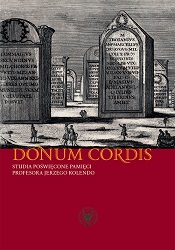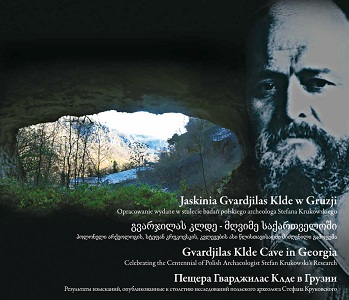Vistula? Vistla? Visculus? Nazwa Wisły w Naturalis historia Pliniusza Starszego
Author(s): Tomasz Płóciennik / Language(s): English,Polish,German
/ Publication Year: 0
Keywords: Jerzy Kolendo; archaeology; Poland; Europe; University of Warsaw; Polish Academy of Sciences
The name of the Wisła river, the only toponym from the territories of present-day Poland mentioned by ancientwriters that has a clear meaning, appears in the Naturalis historia of Pliny the Elder four times (IV 81, IV 97 and –twice – IV 100). However, as a result of the manuscript tradition, it has been preserved in various, often corruptversions, as is also the case with the tradition of other ancient geographical treatises, including the Chorographiaof Pomponius Mela. The earliest publishers of Naturalis historia, following the postulates of Hermolaus Barbarus(1492), always reduced the hydronym – in three of the above-mentioned places – to the Vistula version, popularizedas the name of the Wisła river in humanist Latin. The fi ndings of Jean-Antoine Letronne (1814), based on thestudy of the tradition of the map of Agrippa found in Pliny, as well as two late antique geographical treatises,Divisio orbis terrarum and Dimensuratio provinciarum, and the medieval treaty Liber de mensura orbis terrae writtenby the Irish monk Dicuil, have allowed him to propose the form Vistla as a conjecture for these three places inNaturalis historia. This article – by attempting to ascertain which sources were used in each instance – aims todetermine which forms of the name of the river were written down by Pliny in each of the four mentioned places.The conclusions are as follows: When describing the borders and the size of Dacia (IV 81) – in reference to Agrippa’s map – Pliny usedthe name Vistla found on the map (accusative: Vistlam). Thus, here the text should read: Agrippa totum eumtractum ab Histro ad Oceanum bis ad decies centenum milium passuum in longitudinem, quattuor milibus minusCCCC in latitudinem ad fl umen V i s t l am a desertis Sarmatiae prodidit. The same name was also used in the late antique work Divisio orbis terrarum, which was also referring toAgrippa’s map, while in Dicuil’s medieval treaty it already appeared in its corrupt form as Hiustia. While presenting the Baltic coast (IV 97), Pliny used the Latinized version of the Greek name of Wisła,Οὐιστου՛λας (Vistulas, accusative: Vistulam), borrowed from some, probably Greek, source (Philemon?) whichdescribed this body of water and its coastline clockwise. The text should thus read: Quidam haec habitari adV i s t u l am usque fl uvium a Sarmatis, Venedis, Sciris, Hirris tradunt. The same name – perhaps corrupt from the very beginning and appearing as insulae – was used in Dicuil’streaty in the fragment in which he refers to this part of Pliny’s work and also – though in this case it isdiffi cult to explain the mechanism of such a tradition – in the late antique work Dimensuratio provinciarumreferring to Agrippa’s map. The form Vistulas (ablative: Vistula) was also used earlier by Pomponius Mela who, when referring to theborder of Sarmatia (III 33), had probably used the same source as Pliny in the description of the Balticcoastline (Philemon?). The text of this fragment of the work should thus be: Sarmatia intus quam ad marelatior, ab his quae secuntur V i s t u l a amne discreta, qua retro abit usque ad Histrum fl umen inmittitur. In the catalogue of the rivers of Germania (IV 100) Pliny carried out a kind of synthesis of the namespresented so far by providing the two versions of the name Wisła mentioned a little bit earlier: Amnes clariin Oceanum defl uunt: Guthalus, V i s t u l a s sive V i s t l a, Albis, Visurgis, Amisis, Rhenus, Mosa. The formVistla (or Viscla) was also used in the analogous catalogue of the rivers of Germania in Collectanea rerummemorabilium of Solinus, which was modelled on Pliny’s catalogue.
More...


